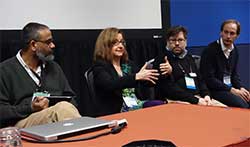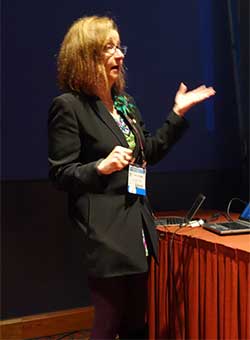From the March Meeting: Session Report: “Why Peer Review?”
By Daniel Ucko

Left to Right: Samindranath Mitra, Laura Greene, Daniel Ucko, and Andrea Taroni.

Laura Greene
In a well-attended session at the APS March meeting in San Antonio, TX, called “Why Peer Review?” on Thursday morning 5 March, several journal editors, a philosopher of science, and a representative of the APS Presidential Line spoke about peer review and its function. First up was Daniel Ucko, a doctoral student in philosophy at Stony Brook University and Associate Editor of Physical Review Letters, a journal of the American Physical Society. Dr. Ucko gave a brief introduction to the history of peer review and its roots in government censorship in England and France, and spoke about the role of referee anonymity as an attempt to attain objectivity in the evaluation process. The philosophical rationale for anonymity is drawn from a comparison with the social and political philosophy of John Rawls.
Next was Samindranath Mitra, Editor of Physical Review Letters, who spoke of the role of peer review and of journals in the Internet age. He described this role as being one of validity and not of dissemination, holding that the journals seek to validate research, not only to certify that it is correct, but also that it is important and of interest. In this sense the journals act as a filter, particularly the “top” journals that are selective and have high impact.
Dr. Mitra pointed out that technological advances, not limited to the Internet but also including LaTeX templates, image processors and other technologies to prepare data for scientific figures, have changed the way we present and communicate science. This extends to other ways of creating content as well — there is no longer a need to have an expensive film camera in order to make a movie in the age of YouTube when you can film using your iPhone. For science, this has resulted in a sharp growth in submissions to journals, now that the obstacles for creating research papers have been lowered and in some cases removed. The appearance of the arXiv preprint server for physics additionally makes it even more important to filter publications, not only in service to the reader but also to help the authors. While in principle all news are free online, we value the curating of an institution like the New York Times for its selection process, editorials/ op-eds, reviews, and other associated content. This is a case for the continued relevance of journals in the internet age. Anonymous peer review appears to be the fairest system, since open review runs the risk of being ruled more and more by reputation. “You are not buying news, you are buying judgment.”
Emerging from both of these first talks was the notion that peer review in its current form, involving referees selected by editors who submit anonymous reports which are passed on to the authors by the editor, is a relatively new phenomenon. Dr. Mitra alluded to a well-known story of Albert Einstein’s experience with peer review at the Physical Review in the 1930’s, as chronicled by Daniel Kennefick. (Einstein Versus the Physical_Review) as an example of this.
Due to unforeseen circumstances, Timothy Smith of the Institute of Physics was not able to give his paper as expected; however, Laura Greene of the University of Illinois stepped in to give a talk in his stead. This talk was a more pedagogical one, centered on the mechanics of peer review, taking an author through the various parts of the process, and explaining how peer review helps authors and readers both by maintaining the standards of the field and providing credibility by vetting research. Since this was a talk originally intended for a workshop on writing scientific papers the focus was very much on clear scientific expression.
Last in this session, before an open Q&A, was Andrea Taroni, Chief Editor of Nature Physics, and previously an editor of Nature Communications. Dr. Taroni outlined the peer review process at Nature journals and the hierarchy of the Nature Publishing Group journals. While there is a clear pyramid with Nature on top, Nature Research Journals (like Nature Physics) next, followed by Nature Communications, with Scientific Reports making up the bottom, Dr. Taroni stressed that all the journals are editorially independent and do not share a referee database. Because Nature and the Nature Research Journals only send a small fraction of their submissions on to external peer review, the nature of their review process is very heavily weighted towards the editor, as it has been throughout Nature’s history. This opens up a comparison of procedures and approaches between these journals and more referee-dependent journals. The additional difference between the Nature Publishing Group and society journals such as those of the American Physical Society and the Institute of Physics, is that the former group has no editorial board or affiliation with a society. As such its connection to the scientific community manifests itself differently. Dr. Taroni also covered different modes of peer review: single-blind/double-blind, open/postpublication review by comments, and transparent, for which all the correspondence is published with the paper. All of these are currently practiced options in the variety of fields in which some form of peer review occurs. This discussion was partially motivated by the fact that the Nature Publishing Group journals have started offering optional doubleblind peer review.
The final Q&A session had questions targeted equally at all the speakers, and when the time was up several were still waiting to ask questions. A particularly interesting question concerned the new bill suggested by a Republican member of congress about making the National Science Foundation (NSF) review process entirely open, revealing reports and the names of the referees. This would change the dynamics of funding review drastically, and serves to highlight that the discussion about peer review reaches far outside of the academy into the realm of politics both national and international.
The articles in this issue represent the views of their authors and are not necessarily those of the Forum or APS.
